Seagate Enterprise NAS HDD 6 TB Review
by Ganesh T S on December 10, 2014 8:00 AM EST- Posted in
- NAS
- Storage
- Seagate
- HDDs
- Enterprise
RAID-5 Benchmarking - Miscellaneous Aspects
Consumers are rightly worried about RAID rebuilds and the scope for drive failures during that process. As one of our evaluation aspects, we randomly yanked out a disk during operation and cleaned it up for rebuild. We recorded the resync duration (time taken to rebuild a 3-disk RAID-5 volume when one of the disks needs to be replaced) as well as the average power consumption during that process. The two aspects, considered together, give an idea of the efficiency of the hard drive. The graph below presents the total energy consumption (Resync Power Consumption (W) X Resync Duration (s)) for the resync.

While the energy consumption aspect provides a consolidated view of the various factors, it is still worthwhile to look at the power consumption and resync duration numbers separately. The table below provides the raw information behind the above graph. The numbers are very similar to the Enterprise Capacity v4, with a slight edge for the Enterprise NAS HDD.
| RAID-5 Resync Power Consumption & Duration | ||
| Drive | Power (W) | Duration (s) |
| Seagate Enterprise NAS HDD | 101.91 | 37284 |
| WD Red | 90.48 | 52072 |
| HGST Ultrastar He6 | 95.36 | 45260 |
| Seagate Enterprise Capacity v4 | 105.42 | 37462 |
We also measured power consumption during the last stage of our multi-client test. With 25 different clients simultaneously stressing the NAS with different types of workloads, we recorded the power consumption at the wall for the NAS as a whole. The various numbers are presented in the graphs below.
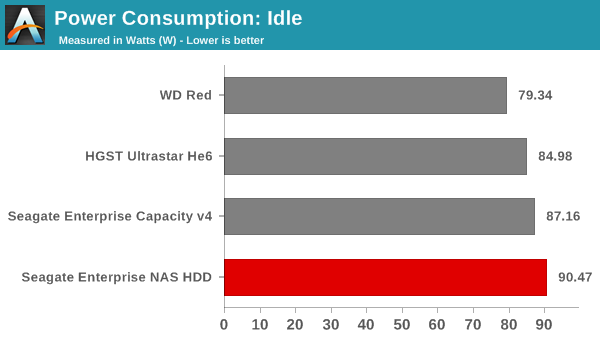
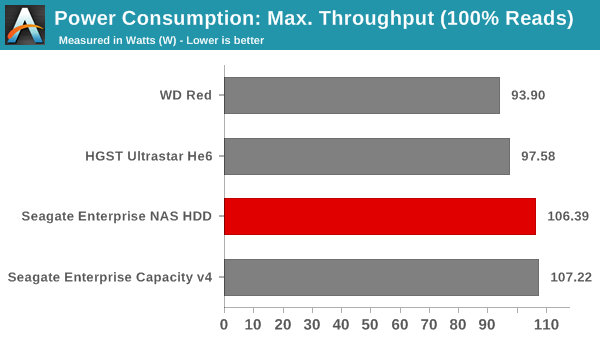
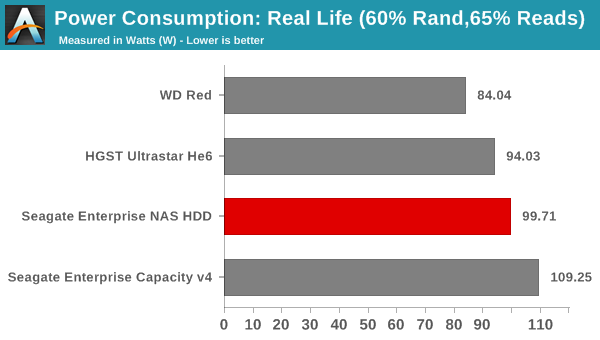
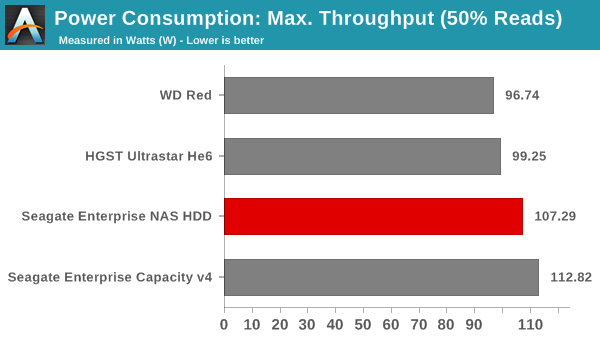
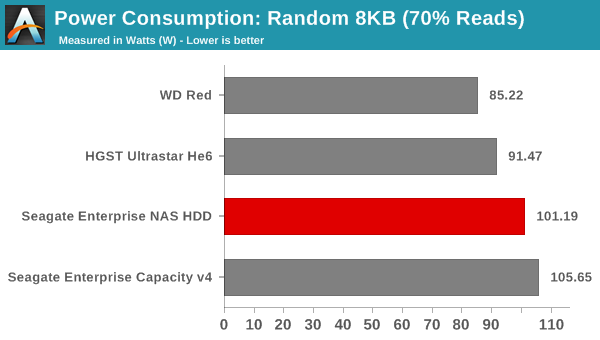
As expected, the units providing better performance have higher power consumption numbers. Workload numbers closely track the rebuild power consumption. The HGST Ultrastar He6, while providing equivalent performance, manages to keep the power consumption low because of the sealed Helium-filled environment for the platters. The Seagate Enterprise Capacity v4 and Enterprise NAS HDD are traditional hard drives that are able to achieve the capacity points using platters with higher storage density (six platters with 1TB/platter).










51 Comments
View All Comments
Supercell99 - Friday, December 12, 2014 - link
Most cloud providers are very slow if you use their storage solutions based on HDD. I am referring to in-house shops that run Dell/HP with Vsphere or Oracle DB's. Anything needing a lot of storage and decent I/O. The price difference to make a drive with SAS interface and SATA is very minimal, but the performance difference can be big when under a lot of simultaneous requests.MrSpadge - Thursday, December 11, 2014 - link
Sure, SAS enterprise HDDs are faster.. but at QD > 32 any HDD is just crawling. For such high loads you really want your hot data to be on flash.hlmcompany - Thursday, December 11, 2014 - link
Exactly. That's why real Enterprise Storage manufacturers, like HGST, provide a host of flash storage, including HH-HL, high capacity, PCI-E storage or low capacity flash caching for large HDD farms.shodanshok - Thursday, December 11, 2014 - link
WD Red drivers seems to have some serious performance bottleneck, even taking into account the slow (5400 RPM) spindle speed.They seem to suffer from an underpowered controller and simplified firmware, as it seem to be unable to coalesce multiple 512B writes in one 4K sector. For example, see how bad the WD Red fares in HD Tach 512B random write test:
WD RED: 25.475 ms
Ent NAS: 6.646 ms
While the enterprise NAS has a larger cache (128 MB vs 64 MB), it is difficult that the cache alone can account for such a large performance improvement in a random write scenario.
On the other side, the random read test is in-line with the different spindle speed (~18.5 ms vs ~14.5 ms)
@ganesh: any possibility to ping WD about that?
theKai007 - Thursday, December 11, 2014 - link
Intel announced the Intel IoT Platform, a reference model end-to-end designed to unify ans simplify connectivity and security for the Internet of Things. http://bit.ly/1yCMSnBBPB - Thursday, December 11, 2014 - link
Are any of these suitable for DVR-type applications? I'd like to get a bigger drive for my WMC setup. I've been using the WD AV-GP series since they are geared towards non-stop I/O in DVR-type usage.Visual - Monday, December 15, 2014 - link
Not at all. Raid helps distribute the data across drives and get some speedup at most linear to the number of drives, but random access is still random access, and is still slow.What romrunning "invented" is a software stack that remaps sectors to make random logical access be physically sequential. I believe some company, maybe Fusion IO, did have something like this, though now that I look for it I can not find anything that is not Flash-based.
The idea can definitely work pretty well for speeding up random writes, but for reads it needs some quite good analysis and statistics about what the commonly read sequences are and does not seem too feasible. Maybe that's why they dropped it and use flash caches.
Visual - Monday, December 15, 2014 - link
And why this did not appear as a reply to the post i clicked 'reply' on (in a new tab)? Anandtech... get some web devs with a brain... it is not rocket science.shodanshok - Monday, December 15, 2014 - link
Modern copy-on-write filesystems as ZFS and BTRFS (and, to a limited extent, even classical filesystems as EXT4 and XFS) do exactly that. They transform random writes in sequential one, using the available space similar to a circular log buffer.For write-intensive, read-insensitive workload they are a great choice, but for some common scenario (eg: databases) they performs quite poorly. Moreover, the resulting files are often very, very much fragmented, leading to very log read performance (when used on top of spinning disks).
For more information and some benchmarks:
- http://www.ilsistemista.net/index.php/linux-a-unix...
- http://en.wikipedia.org/wiki/Log-structured_file_s...
Regards.
akula2 - Thursday, December 18, 2014 - link
This review has some misses w.r.t Enterprise segment. Hardware architecture isn't great. Most importantly this implementation isn't suitable to employers with hundreds of employees accessing data from multiple nations. Lastly, based on my five years of experience in deploying NAS solutions in my businesses I observed Seagate drives fail more than their Hitachi counterparts.